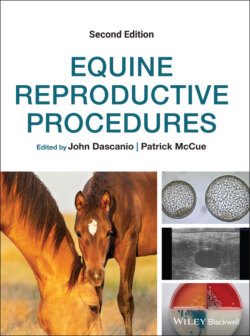Читать книгу Equine Reproductive Procedures - Группа авторов - Страница 53
Оглавление20 Hysteroscopic Examination of the Uterus
Patrick M. McCue
Equine Reproduction Laboratory, Colorado State University, USA
Introduction
Hysteroscopy is the term used for direct visualization of the interior of the uterus using a videoendoscope or fiberoptic endoscope. The true value of an endoscopic examination is detection of pathologic abnormalities within the uterine lumen that cannot be diagnosed by traditional diagnostic techniques. Such abnormalities include intrauterine adhesions (Figure 20.1), retained endometrial cups (Figure 20.2), localized lesions, and focal sites of infection. Endometrial cysts, free fluid within the uterine lumen, and foreign bodies are usually detectable by ultrasound. Similarly, a majority of infectious, inflammatory, and degenerative conditions of the uterus can be detected by culture, cytology, or biopsy.
The major obstacle preventing widespread use of this technique is cost of the equipment.
Equipment and Supplies
Tail wrap, non‐irritant soap, roll cotton, stainless steel bucket, disposable liner for bucket, paper towels, exam gloves, gluteraldehyde disinfectant, sterile saline, obstetrical sleeve, obstetrical lubricant, endoscope (videoendoscope or fiberoptic endoscope), obstetrical sleeves (sterile), sterile obstetrical lubricant, sedation (e.g. detomidine hydrochloride and butorphanol tartrate).
Technique
The endoscope should be cold sterilized before use. This may be accomplished by cold sterilization in an activated solution of 2.4% glutaraldehyde (Cidex®); the endoscope is then thoroughly rinsed with 0.9% sterile saline.
The mare should be restrained in examination stocks and sedated (i.e., 5 mg of detomidine hydrochloride plus 5 mg of butorphanol tartrate IV for a 450 kg mare).
Remove feces from the rectum to prevent contamination of equipment during untimely defecation.
Wrap the tail and then thoroughly wash the perineal area using a non‐residual liquid soap, rinse with warm water, and dry with paper towels (see Chapters 3 & 4).
Apply a small amount of obstetrical lubricant to the gloved hand holding the endoscope.
Manually guide the endoscope into the vagina and gently pass through the cervix into the uterus. The vagina and cervical lumen should be visualized for any discharges (Figure 20.3).
Distend the uterine lumen with air to allow for visualization of the uterine lumen. It will be necessary to hold the cervix closed around the endoscope to maintain insufflation of the uterus. This may be difficult if the mare is in estrus with a relaxed cervix.Figure 20.1 Intrauterine adhesions in a mare viewed through an endoscope.Figure 20.2 Endometrial cups viewed through an endoscope in a mare that lost her pregnancy.Figure 20.3 Normal mare’s cervix viewed by endoscopy.Figure 20.4 Hysteroscopic view of a normal mare’s uterine bifurcation.
Examine the body of the uterus and bifurcation first (Figure 20.4).
Subsequently pass the endoscope up each uterine horn to the tip (Figure 20.5). It should be possible to view the utero‐tubular junction (UTJ) at the tip of each horn (Figure 20.6).
Samples for culture and histology can be obtained through the biopsy port of the endoscope using a double lumen sterile brush such as those used for tracheal diagnostic sampling.Figure 20.5 Hysteroscopic view of a normal mare’s uterine horn.Figure 20.6 Hysteroscopic view of a normal mare’s utero‐tubal papilla (arrow) visible at the end of one uterine horn.Figure 20.7 Marble within the uterine lumen viewed by an endoscope.
It is recommended that broad‐spectrum antibiotics be infused into the uterus after the endoscopic procedure. If the mare was examined during diestrus, it is important to administer a dose of prostaglandins to return the mare to estrus, thus clearing any contaminants and placing the mare into a phase of her cycle better suited to clear bacteria.
Additional Comments
Foreign bodies, such as a marble or the tip of a culture instrument, are easily visualized with an endoscope (Figures 20.7 and 20.8). Videoendoscopy can also be used to deposit a small volume of concentrated spermatozoa at the UTJ as part of a low dose, deep horn insemination protocol. Laser ablation and other types of management of endometrial cysts are also performed using an endoscope. Finally, videoendoscopy can be used to facilitate cannulation of the UTJ to flush the oviducts of mares suspected of oviductal blockage (see Chapter 32).
Figure 20.8 Tip of a uterine culture instrument in the uterine lumen viewed by an endoscope.
Further Reading
1 Bracher V, Allen WR. 1992. Videoendoscopic evaluation of the mare’s uterus: I. Findings in normal fertile mares. Eq Vet J 24: 274–8.
2 Bracher V, Mathias S, Allen WR. 1992. Videoendoscopic evaluation of the mare’s uterus: II. Findings in normal fertile mares. Eq Vet J 24: 279–84.
3 Card CE. 2011. Endoscopic examination. In: McKinnon AO, Squires EL, Vaala WE, Varner DD (eds). Equine Reproduction, 2nd edn. Ames, IA: Wiley Blackwell, pp. 1940–50.
4 Inoue Y, Sekiguchi M. 2018. Clinical application of hysteroscopic hydrotubation for unexplained infertility in the mare. Eq Vet J 50: 470–3.
5 Lindsey AC, Morris LHA, Allen WR, Shenk JL, Squires EL, Bruemmer JE. 2002. Hysteroscopic insemination of mares with low numbers of nonsorted or flow sorted spermatozoa. Eq Vet J 34: 128–32.
6 Rambags BPB, Stout TAE. 2005. Transcervical endoscope‐guided emptying of a transmural uterine cyst in a mare. Vet Record 156: 679–82.
